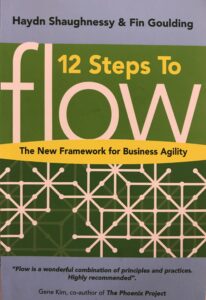Podcast: Play in new window | Download
Subscribe: RSS
This podcast covers Chapter 4, “Taking Advantage of Visible Work” of “12 Steps to Flow: The New Framework for Business  Agility,” by Haydn Shaughnessy and Fin Goulding, developers of the internationally acclaimed workshop, Flow Academy. This chapter deals with introducing visible, observable, work. This is the cornerstone for new organizational culture. It provides a framework for collective intelligence and matrix innovation which requires many granular decisions which everyone can see.
Agility,” by Haydn Shaughnessy and Fin Goulding, developers of the internationally acclaimed workshop, Flow Academy. This chapter deals with introducing visible, observable, work. This is the cornerstone for new organizational culture. It provides a framework for collective intelligence and matrix innovation which requires many granular decisions which everyone can see.
By having a wall with Post-Its everyone can see the decision points and play a key role based on their know-how.
A key component of Flow is social interactions shape knowledge and support decisions. Doing the work visually supports these interactions and addresses the complexity of projects in a threefold manner:
– first off, likes complex anyway and there is no way of getting around
– complexity is more easily managed when an approach is used that allows for collective intelligence rather than hierarchies and plans
– this can be accomplished using walls and Post-It’s.
An example is provided as to how Samsung one about creating the Active Matrix Organic Light Emitting Diode (AMOLED) screen. Two major goals of no backlight and better color saturation were broken down into 50 major problem areas. In turn, these problem areas were broken down into hundreds of problem statements which ended up producing thousands of smaller problems which were essentially viewed as goals which needed to be achieved.
This example was used as an analogy for how Flow works, i.e., instead of problem statements goal statements are used to direct the construction of areas of work and units of work. Addressing these problems visually is superior to creating a grand plan. Visualization and social interaction helps keep everyone on board. Visualization and smaller units of work are effective tools for mastering complexity. The team is free to develop its own culture and interactions that are appropriate for solving the problems.
An interesting point that is made is that many people have emotional intelligence but they lack emotional resilience. Emotional resilience is the ability to stand up for ideas one believes in. Visualization helps people develop emotional resilience. The reason is people can actually see how the work is progressing, or not, which helps them look at the situation in a straightforward manner and develop a collective intelligence. The Walls with the Post-It’s create venues where discussions can occur that promote the resilience.
With this approach risk and issues receive greater exposure.
These walls essentially become a visual documentation of the organizations learning.
The authors point out that by having visual manifestation of work it’s easy for everyone to observe the work-in-progress to get an idea of how well the project is moving forward. This is especially important when a lot of the work is being performed is brand-new.
It is important to have a wall for the various frames-of-mind appropriate for the project, e.g., the customer innovation wall, and appreciation wall, an executive portfolio, the customer feedback wall, etc. This is referred to as extreme visualization.
The chapter concludes with the steps required to implement extreme visualization are:
1. Sufficient wall space. The corridor that everyone uses is a great space.
2. Anticipate resistance. Coaxing executives to participate can be one of the most difficult aspects of the work. Regardless, it is good start with a customer wall and an executive portfolio wall.
3. Adaptation. See if you can find a pressing project that can serve as a focal point to begin practicing extreme visualization. This will encourage maximum involvement.
4. Research. Customer walls, for example, may require social media research or examination of existing files in order to populate the wall. Likewise, for an executive portfolio wall data from all projects needs to be gathered and displayed.
5. The first draft. It may be difficult and/or uncomfortable to get a particular wall started. This is where a facilitator for the first day or two can be beneficial. Sometimes there may be a team member who happens to be good at facilitation. Use that person but don’t let them become too prominent. This is meant to be a team effort.
6. Reporting. Resist the urge to create write ups from the walls. Use photos, not reports.
7. Tools to have on hand:
– a learning wall where people can document the learning process
– the go to market plan. This provides a valid and disciplined way to think about the market when you’re creating products or services.
– plenty of Post-It’s and markers
– a camera. Smartphone may be sufficient. The goal is to routinely take pictures on a daily basis to avoid the temptation of writing things up.
Here are the link for:
episode 0037 of Wrestling with Chaos. the Introduction, The Value Seeking Enterprise, and Chapter 1, Talking About Business Agility:
episode 0042 of Wrestling With Chaos. For Chapter 2, The Customer In The Agile Business.
episode 0043 of Wrestling With Chaos. For Chapter 3, Disrupting The Cadence of Work
For more on the various “Walls” using Post-Its refer to their excellent book, “Flow.”
In line with Business Agility and dealing with complex situations, you can download CMC’s free e-book MINDSET – 5 SIMPLE WAYS TO LOOK AT COMPLEX PROBLEMS and learn how to find a simple vantage point from which you can resolve challenges.
Your feedback is important. Choose from the following options:
- place a review in iTunes,
- click on “leave a comment” below,
- send any comments along with your name and the show number to support@ctrchg.com
Listen to future episodes for our reply.


Recent Comments